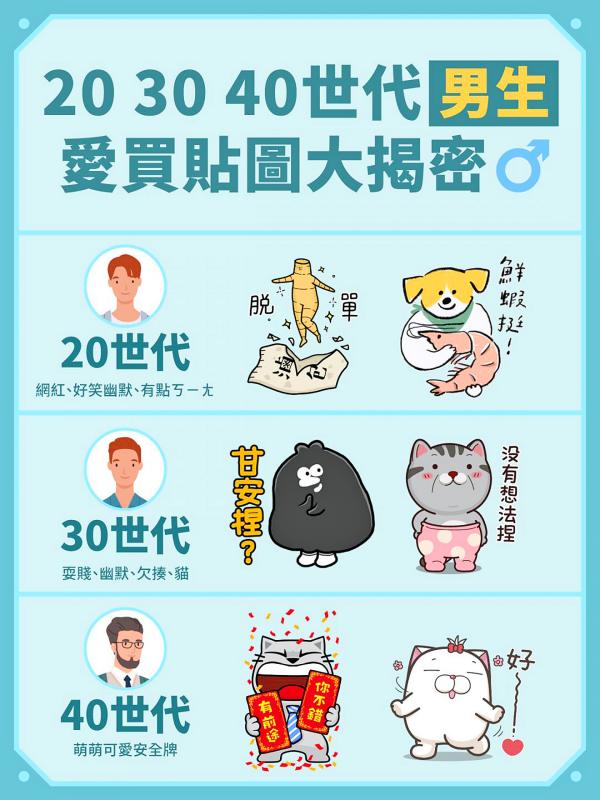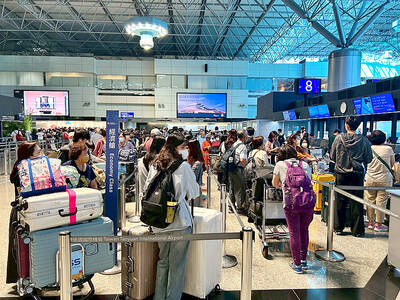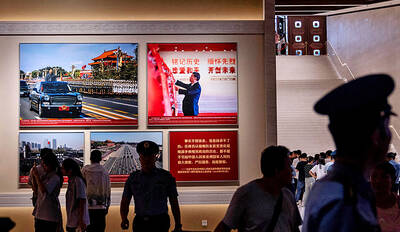Taiwan has 21 million registered users of the messaging app Line, with each user downloading an average of 18 sets of stickers last year, twice as many as Japanese users, Line Corp said on Thursday in its annual report.
The report, which investigated users’ sticker-using habits, said that male users in their 20s preferred stickers that are humorously dramatic, such as Very Miss Rabbit (好想兔) by Chien Chien (謙謙創藝), or stickers created by db Huang (帶筆晃晃).
Men in their 30s liked to use stickers of funny characters, such as cats, especially those that come with annoying looks or words, such as cat stickers by Vita Vita; while 40-something men enjoyed “super cute” stickers, such as Brown and Cony (熊大兔兔) and Meow Zhua Zhua (貓爪抓) by Mr Gardener (園丁先生), it said.

Photo: Screen grab from Line messenger
Female users in their 20s favored stickers that are both cute and sassy, such as Ology (奧樂雞) by HIM International Music and Ugly White Rabbit (醜白兔) by Paul (保羅); while women in their 30s love heartwarming stickers, such as Usakkuma (熊兔寶) by Musikyoto, it said.
Women in their 40s tended to use girly stickers as a way to reveal their hearts, as well as pop-up stickers, which fill the screen for a few seconds after being sent, it added.
Females were more willing to purchase stickers that express affection, while the main customer group that would buy stickers for other users was males in their 20s, the report added.

Photo: Screen grab from Line messenger

Three batches of banana sauce imported from the Philippines were intercepted at the border after they were found to contain the banned industrial dye Orange G, the Food and Drug Administration (FDA) said yesterday. From today through Sept. 2 next year, all seasoning sauces from the Philippines are to be subject to the FDA’s strictest border inspection, meaning 100 percent testing for illegal dyes before entry is allowed, it said in a statement. Orange G is an industrial coloring agent that is not permitted for food use in Taiwan or internationally, said Cheng Wei-chih (鄭維智), head of the FDA’s Northern Center for

The Chinese military has built landing bridge ships designed to expand its amphibious options for a potential assault on Taiwan, but their combat effectiveness is limited due to their high vulnerability, a defense expert said in an analysis published on Monday. Shen Ming-shih (沈明室), a research fellow at the Institute for National Defense and Security Research, said that the deployment of such vessels as part of the Chinese People’s Liberation Army (PLA) Navy’s East Sea Fleet signals a strong focus on Taiwan. However, the ships are highly vulnerable to precision strikes, which means they could be destroyed before they achieve their intended

About 4.2 million tourist arrivals were recorded in the first half of this year, a 10 percent increase from the same period last year, the Tourism Administration said yesterday. The growth continues to be consistent, with the fourth quarter of this year expected to be the peak in Taiwan, the agency said, adding that it plans to promote Taiwan overseas via partnerships and major events. From January to June, 9.14 million international departures were recorded from Taiwan, an 11 percent increase from the same period last year, with 3.3 million headed for Japan, 1.52 million for China and 832,962 to South Korea,

REWRITING HISTORY: China has been advocating a ‘correct’ interpretation of the victory over Japan that brings the CCP’s contributions to the forefront, an expert said An elderly Chinese war veteran’s shin still bears the mark of a bullet wound he sustained when fighting the Japanese as a teenager, a year before the end of World War II. Eighty years on, Li Jinshui’s scar remains as testimony to the bravery of Chinese troops in a conflict that killed millions of their people. However, the story behind China’s overthrow of the brutal Japanese occupation is deeply contested. Historians broadly agree that credit for victory lies primarily with the Chinese Nationalist Party (KMT)-led Republic of China (ROC) Army. Its leader, Chiang Kai-shek (蔣介石), fled to Taiwan in 1949 after losing a